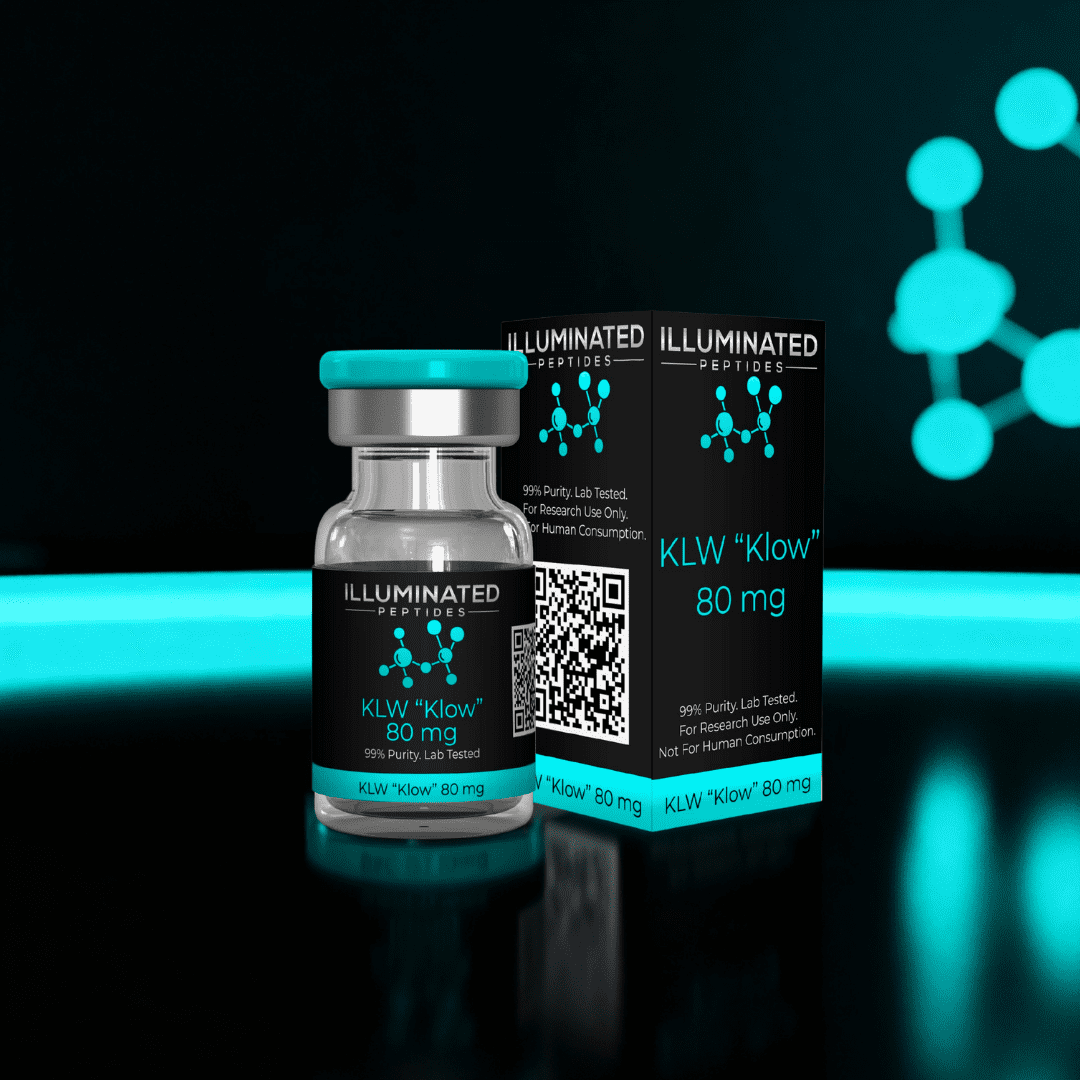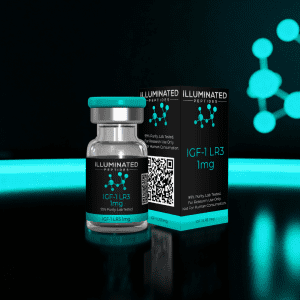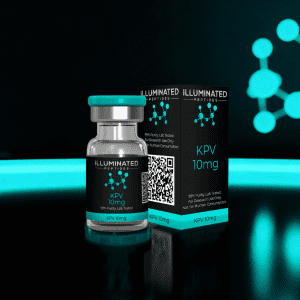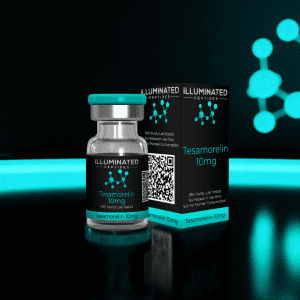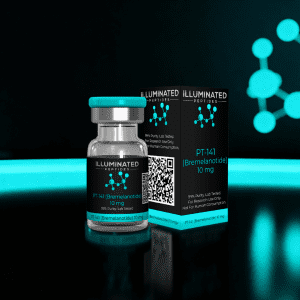Description
KLW “Klow”
KLW “Klow” is a research-grade peptide formulation featuring GHK-Cu, a naturally occurring tripeptide first identified in human blood plasma and later detected in urine and saliva. Research shows that GHK-Cu plays an important role in tissue repair and immune support, making KLW “Klow” a key subject of interest in regenerative studies.
This peptide has been found to regulate protein synthesis and stimulate fibroblast activity, contributing to enhanced skin repair, elasticity, and overall health. KLW “Klow” also displays antioxidant effects, helping to counteract free-radical damage, while its antimicrobial properties may support the preservation of tissue integrity. Preclinical findings further suggest that GHK-Cu possesses anti-aging and cellular renewal potential, positioning KLW “Klow” as a valuable compound for laboratory investigations into skin and tissue rejuvenation.
KLW “Klow” Structure
Sequence: Gly-His-Lys · Cu·XHAc
Molecular Formula: C14H23CuN6O4
Molecular Weight: 401.91 g/mol
PubChem CID: 73587
CAS Number: 89030-95-5
KLW “Klow” Research
KLW “Klow” and Skin Healing
KLW “Klow,” which contains GHK-Cu, a naturally occurring tripeptide present in human blood plasma, urine, and saliva, has been extensively studied for its role in tissue repair and regeneration. Research shows that KLW “Klow” helps regulate the synthesis and breakdown of collagen, glycosaminoglycans, and other extracellular matrix components, supporting improvements in skin elasticity, firmness, and resilience.
Preclinical studies and topical research suggest that KLW “Klow” may reduce UV-induced skin damage, minimize hyperpigmentation, and improve the appearance of fine lines and wrinkles. It promotes fibroblast activity, enhances skin density, and improves texture, leading to healthier and more youthful-looking skin. Animal studies also indicate that KLW “Klow” can accelerate wound closure and improve tissue remodeling, supporting angiogenesis and keratinocyte migration.
KLW “Klow” and Antimicrobial Support
KLW “Klow” demonstrates antimicrobial effects that may inhibit bacterial and fungal growth in damaged tissues. This is especially relevant in conditions with compromised immunity, such as diabetes or chronic wounds. Research indicates that KLW “Klow” can improve wound healing outcomes by reducing infection risks and enhancing closure rates when compared with control conditions.
KLW “Klow” and Nervous System Health
Studies suggest that KLW “Klow” may support neuronal survival, synaptic repair, and cognitive function. It has been detected in regions of the brain associated with memory and learning. Preclinical research indicates that KLW “Klow” can reduce neuroinflammation, stimulate neuron outgrowth, and regulate stress-response mechanisms, potentially contributing to neuroprotection and the preservation of healthy neural networks.
KLW “Klow” and Chemotherapy Protection
Experimental models have explored KLW “Klow” for its potential in reducing oxidative stress and inflammation linked to chemotherapy. Findings suggest that it may decrease fibrosis, promote tissue recovery, and regulate cytokine-driven pathways of remodeling, particularly in lung tissue. These properties make KLW “Klow” a valuable candidate for research into protective support during cytotoxic treatments.
KLW “Klow” and Pain Modulation
Research highlights the potential of KLW “Klow” in pain modulation. Preclinical studies indicate that it may lower pain perception, reduce swelling, and decrease tissue sensitivity, possibly through the regulation of inflammatory mediators and interaction with opioid pathways. These findings make KLW “Klow” of interest in studies of chronic, inflammatory, or neuropathic pain.
KLW “Klow” and Collagen Remodeling
One of the key mechanisms attributed to KLW “Klow” is its ability to regulate collagen metabolism. Studies show that it can stimulate new collagen synthesis while simultaneously promoting the breakdown of abnormal or damaged collagen. This dual role may support scar reduction, improved tissue elasticity, and healthier extracellular matrix remodeling.
KLW “Klow” and Angiogenesis
Research has demonstrated that KLW “Klow” can promote angiogenesis, the formation of new blood vessels, which is critical for wound repair and tissue regeneration. By stimulating vascular endothelial growth factor (VEGF) pathways, KLW “Klow” may enhance oxygen and nutrient delivery to healing tissues, supporting faster recovery and improved tissue integrity.
KLW “Klow” and Oxidative Stress Defense
KLW “Klow” exhibits antioxidant activity, helping to neutralize free radicals and reduce oxidative stress within cells. By protecting against reactive oxygen species (ROS), it may slow cellular aging, protect DNA, and maintain mitochondrial function, making it a valuable subject of research in anti-aging and longevity studies.
KLW “Klow” and Immune Modulation
Evidence suggests that KLW “Klow” can influence immune responses by balancing pro- and anti-inflammatory signaling. By regulating pathways such as NF-κB, it may limit chronic inflammation while enhancing regenerative healing. This dual action highlights its potential role in managing immune-related tissue damage in experimental studies.
KLW “Klow” and Hair Follicle Support
Research on GHK-Cu indicates potential benefits for hair follicle stimulation and enlargement. KLW “Klow” has been studied for its ability to improve follicle size, increase hair density, and support growth cycles. These findings make it an interesting subject for investigations related to hair regeneration and dermatological health.
KLW “Klow” and Muscle/Tendon Repair
Preclinical studies suggest that KLW “Klow” may play a role in musculoskeletal regeneration. By enhancing fibroblast and myoblast activity, it could support tendon repair, muscle recovery, and connective tissue resilience. This line of research points to KLW “Klow” as a promising tool for understanding tissue regeneration in injury models.
KLW “Klow” and Cellular Signaling Pathways
Investigations show that KLW “Klow” may regulate key signaling pathways such as TGF-β, VEGF, and NF-κB. These pathways are central to cell growth, angiogenesis, inflammation, and tissue remodeling. By modulating these molecular signals, KLW “Klow” may exert wide-ranging biological effects that make it a versatile peptide in research contexts.
Safety and Research Status
KLW “Klow” has shown favorable tolerability in laboratory studies with minimal adverse effects reported. Owing to its stability, bioavailability, and broad regenerative potential, KLW “Klow” is considered a promising compound for continued research in skin, tissue, musculoskeletal, and neurological health.

